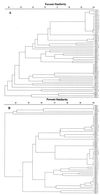Genotypic heterogeneity of Streptococcus oralis and distinct aciduric subpopulations in human dental plaque
- PMID: 10919787
- PMCID: PMC92151
- DOI: 10.1128/AEM.66.8.3330-3336.2000
Genotypic heterogeneity of Streptococcus oralis and distinct aciduric subpopulations in human dental plaque
Abstract
The genotypic heterogeneity of Streptococcus oralis isolated from the oral cavity was investigated using repetitive extragenic palindromic PCR. Unrelated subjects harbored unique genotypes, with numerous genotypes being isolated from an individual. S. oralis is the predominant aciduric bacterium isolated from noncarious tooth sites. Genotypic comparison of the aciduric populations isolated at pH 5.2 with those isolated from mitis-salivarius agar (MSA) (pH 7.0) indicated that the aciduric populations were genotypically distinct in the majority of subjects (chi(2) = 13.09; P = 0.0031). Neither the aciduric nor the MSA-isolated strains were stable, with no strains isolated at baseline being isolated 4 or 12 weeks later in the majority of subjects. The basis of this instability is unknown but is similar to that reported for Streptococcus mitis. Examination of S. oralis strains isolated from cohabiting couples demonstrated that in three of five couples, genotypically identical strains were isolated from both partners and this was confirmed by using Salmonella enteritidis repetitive element PCR and enterobacterial PCR typing. These data provide further evidence of the physiological and genotypic heterogeneity of non-mutans streptococci. The demonstration of distinct aciduric populations of S. oralis implies that the role of these and other non-mutans streptococci in the caries process requires reevaluation.
Figures



Similar articles
-
Effect of the environment on genotypic diversity of Actinomyces naeslundii and Streptococcus oralis in the oral biofilm.Appl Environ Microbiol. 2003 Nov;69(11):6475-80. doi: 10.1128/AEM.69.11.6475-6480.2003. Appl Environ Microbiol. 2003. PMID: 14602602 Free PMC article.
-
Strain-related acid production by oral streptococci.Caries Res. 2000 Nov-Dec;34(6):486-90. doi: 10.1159/000016628. Caries Res. 2000. PMID: 11093023
-
Isolation and Bacteriocin-Related Typing of Streptococcus dentisani.Front Cell Infect Microbiol. 2019 Apr 16;9:110. doi: 10.3389/fcimb.2019.00110. eCollection 2019. Front Cell Infect Microbiol. 2019. PMID: 31041198 Free PMC article.
-
The complex oral microflora of high-risk individuals and groups and its role in the caries process.Community Dent Oral Epidemiol. 2005 Aug;33(4):248-55. doi: 10.1111/j.1600-0528.2005.00232.x. Community Dent Oral Epidemiol. 2005. PMID: 16008631 Review.
-
Putative pathogenic factors underlying Streptococcus oralis opportunistic infections.J Microbiol Immunol Infect. 2025 Apr;58(2):157-163. doi: 10.1016/j.jmii.2024.09.001. Epub 2024 Sep 6. J Microbiol Immunol Infect. 2025. PMID: 39261123 Review.
Cited by
-
Surviving the acid test: responses of gram-positive bacteria to low pH.Microbiol Mol Biol Rev. 2003 Sep;67(3):429-53, table of contents. doi: 10.1128/MMBR.67.3.429-453.2003. Microbiol Mol Biol Rev. 2003. PMID: 12966143 Free PMC article. Review.
-
Reproducibility of a new caries risk test under different oral conditions.Clin Oral Investig. 2005 Sep;9(3):187-91. doi: 10.1007/s00784-005-0316-5. Epub 2005 May 25. Clin Oral Investig. 2005. PMID: 15915342
-
Population structure of Streptococcus oralis.Microbiology (Reading). 2009 Aug;155(Pt 8):2593-2602. doi: 10.1099/mic.0.027284-0. Epub 2009 May 7. Microbiology (Reading). 2009. PMID: 19423627 Free PMC article.
-
Analysis of Streptococcus mutans proteins modulated by culture under acidic conditions.Appl Environ Microbiol. 2002 May;68(5):2382-90. doi: 10.1128/AEM.68.5.2382-2390.2002. Appl Environ Microbiol. 2002. PMID: 11976112 Free PMC article.
-
Population diversity and dynamics of Streptococcus mitis, Streptococcus oralis, and Streptococcus infantis in the upper respiratory tracts of adults, determined by a nonculture strategy.Infect Immun. 2008 May;76(5):1889-96. doi: 10.1128/IAI.01511-07. Epub 2008 Mar 3. Infect Immun. 2008. PMID: 18316382 Free PMC article.
References
-
- Alaluusua S, Malmivirta R. Early plaque accumulation: a sign of caries risk in young children. Community Dent Oral Epidemiol. 1994;22:273–276. - PubMed
-
- Beighton D, Hayday H, Walker J. The relationship between the number of the bacterium Streptococcus mutans at discrete sites on the dentition of macaque monkeys (Macaca fascicularis) and the subsequent development of dental caries. Arch Oral Biol. 1985;30:85–88. - PubMed
-
- Beighton D, Hardie J M, Whiley R A. A scheme for the identification of viridans streptococci. J Med Microbiol. 1991;35:367–372. - PubMed
-
- Beighton D, Smith K, Hayday H. The growth of bacteria and the production of exoglycosidic enzymes in the dental plaque of macaque monkeys. Arch Oral Biol. 1986;31:829–835. - PubMed
Publication types
MeSH terms
LinkOut - more resources
Full Text Sources
Medical

